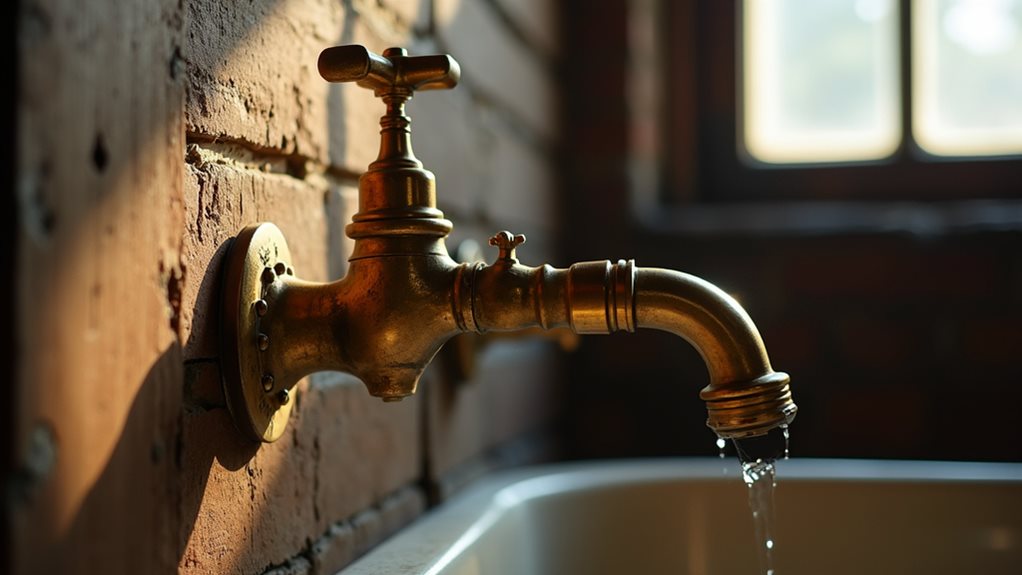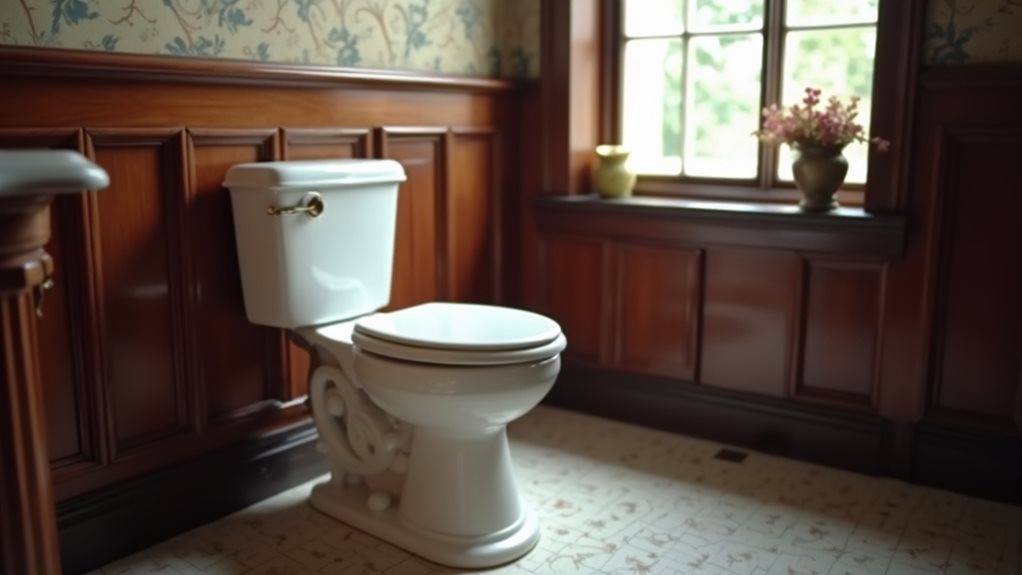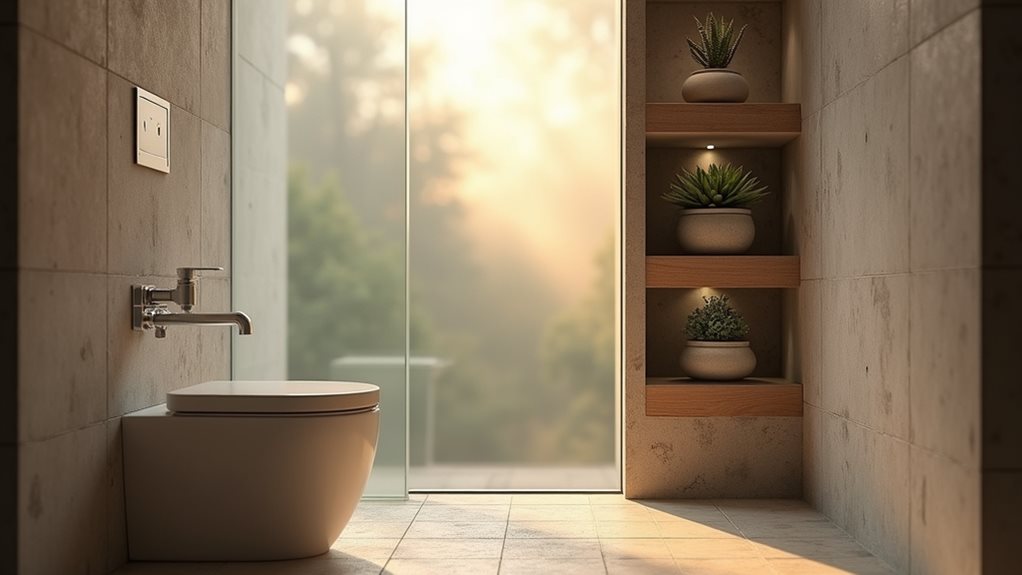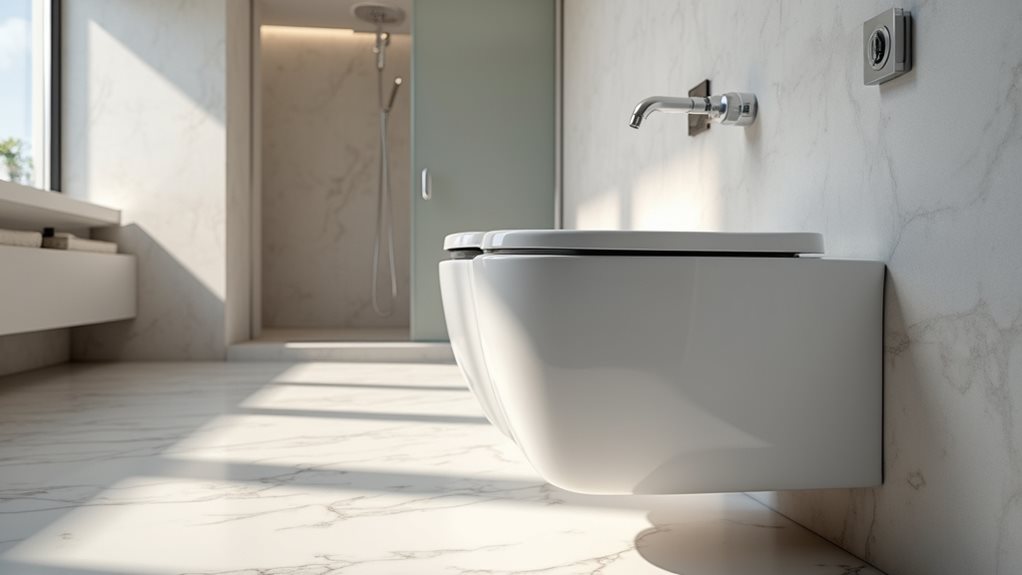A water closet isn’t just a fancy term for bathroom—it’s a revolutionary sanitation concept coined in 1755 that changed civilization from disease-ridden communities using chamber pots to modern hygienic societies. You’ll find this small, private room equipped with flushing toilets gained momentum after Sir John Harington’s 16th-century invention, while Thomas Twyford’s ceramic “Unitas” model made single-piece toilets standard. The widespread adoption created centralized sewer systems, dramatically reducing disease transmission and establishing the foundation for today’s smart toilet innovations.
TLDR
- A water closet is simply a toilet room, coined in 1755 to describe small private rooms with flushing toilets.
- The term “WC” became globally recognized after Thomas Twyford’s 1880s “Unitas” ceramic toilet model spread worldwide.
- Water closets revolutionized public health by eliminating contaminated water supplies and reducing disease transmission in cities.
- Modern water closets feature smart technology including heated seats, automatic flushing, and bidet systems with app connectivity.
- The Russian word “унитаз” for toilet literally comes from the brand name “Unitas,” showing this innovation’s global impact.
The Surprising Origins of Water Closet Terminology

While many people today use terms like “bathroom” or “restroom” interchangeably, the phrase “water closet” carries a surprisingly specific historical meaning that dates back to the mid-18th century.
Originally coined around 1755, it described a small private room equipped with a flushing toilet system, distinguishing it from chamber pots or outhouses that lacked running water. The concept gained momentum following Sir John Harington’s introduction of the flushing toilet in the 16th century, which laid the groundwork for these revolutionary sanitation systems. In many ways, the evolution of the water closet mirrors advancements in grass growth and landscaping, as both reflect the changing needs and innovations of society over time.
From Victorian England to Modern Homes: A Historical Journey
As Victorian England entered the mid-19th century, the evolution of bathroom facilities began changing from crude outdoor necessities into sophisticated indoor conveniences that would eventually reshape domestic life across the globe. Drywall primer plays a crucial role in enhancing the overall quality of interior spaces, ensuring that paint adheres properly to surfaces. You’d find two main bathroom types emerging: wood-paneled rooms and hygienic porcelain white bathrooms, with hybrid versions combining traditional elements with modern conveniences. The first flush toilet was invented by Thomas Crapper in 1861, utilizing gravity for flushing and marking a revolutionary step toward modern bathroom sanitation.
Thomas Twyford’s Revolutionary Ceramic Toilet Invention

Thomas Twyford’s innovative invention of the single-piece ceramic flush toilet in the late 19th century revolutionized an industry dominated by cumbersome multi-piece designs and inferior materials.
His 1883 “Unitas” model featured vitreous china construction, replacing metal and wood fixtures that were difficult to clean.
You’ll find his design’s impact extraordinary—the term “унитаз” became synonymous with “toilet” in Russian. Additionally, just as Twyford transformed sanitation, proper care tips for healthy trees can greatly improve the yield and health of potted lemon trees.
How Water Closets Transformed Public Sanitation
Following Twyford’s ceramic innovations, the widespread adoption of water closets fundamentally changed public sanitation by shifting waste disposal from dangerous, decentralized methods to controlled, centralized systems.
You’ll find that this change reduced disease transmission by eliminating contaminated water supplies and cesspits.
Cities developed extensive sewer networks to handle increased sewage flow, ultimately improving urban environmental health standards markedly.
Design Benefits That Go Beyond Privacy

While water closets revolutionized public health through improved sanitation systems, their impact on modern bathroom design extends far beyond these historical achievements.
You’ll find that today’s enclosed toilets maximize space utilization, reduce airborne contaminants, and enable simultaneous bathroom use. They also muffle operational sounds, contain odors effectively, and increase your home’s market value greatly.
Materials and Engineering Innovations Through the Decades
You’ll find that water closet technology has evolved dramatically from its humble beginnings with basic earthenware materials to today’s sophisticated ceramic and plastic hybrid systems.
The engineering breakthroughs you see in modern toilets stem from centuries of innovation, particularly in trap mechanisms that prevent sewer gases from entering your home and flushing systems that maximize efficiency while minimizing water waste.
These material advancements and mechanical improvements haven’t just enhanced durability and performance—they’ve fundamentally altered public health standards and environmental sustainability in ways that continue to influence bathroom design today.
Early Earthenware and Ceramic
The evolution of water closet materials represents a fascinating expedition from ancient clay structures to today’s sophisticated ceramic fixtures.
You’ll find that early civilizations in Mesopotamia and the Indus Valley employed clay pipes for sanitation dating back to the fourth millennium BC.
These ceramic surfaces provided easier cleaning due to their smooth, non-porous properties compared to alternative materials.
Trap Types and Mechanisms
As water closet technology advanced beyond basic ceramic improvements, engineers turned their attention to solving one of the most persistent problems in early sanitation systems: preventing sewer gases from entering living spaces.
Alexander Cummings’s 1775 S-trap invention used standing water as a barrier, but siphon effects caused seal failures.
Later P-trap designs added ventilation systems, reducing siphon risks and maintaining consistent water levels for reliable odor control.
Modern Efficiency Patents
Following decades of incremental improvements to trap systems, toilet manufacturers in the mid-20th century began filing patents that would revolutionize water closet efficiency through breakthrough materials and engineering designs.
You’ll find advanced ceramics and high-quality materials enhanced durability while reducing water consumption.
Dual-flush systems, improved insulation, and innovations like Toto’s G-max vacuum technology converted modern toilets into efficient, sustainable fixtures.
Regional Differences in Water Closet Usage and Names
While “water closet” originated in 1870s England, you’ll find that different regions have developed their own distinctive ways of using and naming this essential facility.
Americans use “WC” in plumbing codes for toilet spaces, while Europeans commonly display “WC” on signage.
Local adaptations include Spanish “váter,” French “waters,” and Romanian “veceu,” all derived from the original English term.
Why Water Closets Are Today’s Ultimate Bathroom Upgrade

Beyond the varied terminology and cultural adaptations found across different regions, water closets have evolved into one of the most sought-after bathroom features in modern home design.
You’ll benefit from improved hygiene through contained airborne contaminants, enhanced privacy for simultaneous bathroom use, and increased property value that appeals to potential buyers seeking luxury features.
The Future of Enclosed Toilet Spaces in Home Design
You’re witnessing the beginning of a revolutionary change in water closet design, where advanced technology seamlessly integrates with traditional functionality to create intelligent, responsive spaces.
The future promises compact solutions that maximize every square inch through innovative layouts and multi-purpose features, while sustainable materials take center stage as environmentally conscious homeowners demand eco-friendly alternatives without compromising style or durability.
These three converging trends will reshape how you think about enclosed toilet spaces, turning them from purely functional areas into sophisticated, tech-enabled sanctuaries that reflect both your values and lifestyle preferences.
Smart Technology Integration
As smart home technology continues to reshape residential living, the integration of intelligent toilet systems within enclosed water closets represents one of the most significant advances in bathroom design and functionality.
Modern smart toilets offer bidet systems, heated seats, automatic flushing, and self-cleaning nozzles that enhance hygiene and comfort while connecting seamlessly to your existing smart home network.
Space-Saving Design Solutions
While modern homes continue to shrink in square footage, the future of enclosed toilet spaces lies in revolutionary space-saving design solutions that maximize functionality without compromising comfort or style.
You’ll find strategic shelving placement and inset cabinets reduce footprint while maintaining storage capacity.
Doorless closet designs and wall-mounted fixtures optimize floor space, making compact water closets feel surprisingly spacious.
Sustainable Materials Revolution
Beyond maximizing square footage, today’s water closet designs are embracing an environmental consciousness that’s reshaping how we think about bathroom materials and construction.
You’ll find eco-friendly toilets crafted from recycled porcelain and ceramic, bamboo toilet seats offering moisture resistance, and stainless steel fixtures providing long-lasting durability.
These sustainable materials reduce carbon footprints while conserving water resources.
Final Note
You’ve uncovered that water closets represent far more than simple bathroom fixtures—they’re structural innovations that changed sanitation, privacy, and home design throughout history. From Thomas Twyford’s ceramic breakthroughs to today’s sophisticated enclosed spaces, water closets continue developing with modern materials and engineering advances. Whether you’re renovating or building new, understanding these functional elements helps you make informed decisions about incorporating water closets into your home’s design strategy.